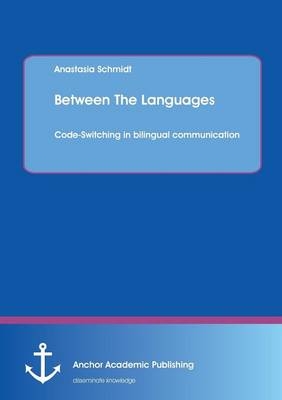
Between The Languages: Code-Switching in bilingual communication
Anchor Academic Publishing (Verlag)
9783954892495 (ISBN)
Such kinds of switches call for a special competence of the two languages involved. But how well the bilinguals have to know each of the languages is a justifiable question. These switches are not arbitrary since they may depend on the situation of the conversation, the topic of the conversation, the emotional aspects involved, the language preference of the speaker and the need to express the own identity. The goal of this book is to look in detail at code-switching in bilingual communication with the help of the present study on Russian-German bilinguals.
Anastasia Schmidt was born in 1984 in Lissakowsk / Kazakhstan. In 2010 she graduated from the University of Stuttgart. In this book she looks in detail at code-switching in bilingual communication with the help of the present study on Russian-German bilinguals.
Chapter III, Theories of Code-switching:
As already mentioned in the short research overview in subchapter 2.4, the phenomenon of code-switching was and still is being studied from various perspectives. Much of the work on code-switching, however, is dedicated to the grammatical aspects of language alternation. Grammatical analysis of code-switched sentences plays an important role and is therefore one main part of code-switching research. Many linguistic studies are concerned with investigating rules of code-switching and there are different proposals. A central aspect researchers on code-switching grammar are interested in is trying to find grammatical constraints which show where and when code-switching is possible, i.e. where it is not acceptable because of the violation of the rules. They observed that code-switching, for instance, occurs only at specific points in a sentence and not arbitrarily, i.e. the occurrence of code-switching appears to be rule-governed.
One problem in code-switching research, however, is that code-switching is mainly found in natural and spontaneous speech. Fully grammatical sentences are rarely found in code-switching data sets. This could be a problem for applying correctly grammatical theories on code-switching in general and, as for my interest, especially Poplack s constraints and Myers-Scotton s MLF model.
Another significant facet in code-switching research from the point of view of grammar is the question as to whether the linguistic constraints are applied language-specifically, i.e. depending on the studied languages, or universally, i.e. applicable to all languages. The search for universal constraints started around 1980 (cf. Appel & Muysken 1987: 121). Most of the previous studies were predominantly concentrated on one linguistic area.
Thus, in this section, I will concentrate on two major grammatical approaches to analysing the phenomenon of code-switching. Chapter 4 deals with Poplack s Two Constraint Model and in chapter 5, Myers-Scotton s MLF model is presented. In the last subchapter of each theory, the main aspects will be discussed and hypotheses for the present case study will be presented.
The MLF model is regarded as being a not purely grammatical model. The notion of ML has not been much investigated till the introduction of Myers-Scotton s MLF model. Determining the base language if it is at all possible as both languages can have an equal role was thought to be a difficult procedure since some bilinguals switch equally and frequently between languages, even within one semantic domain (cf. Grosjean 1982: 321). Some other studies, however, show that there are also cases where the two languages involved can clearly be identified as either ML or EL. Appel & Muysken (1987: 121) considered the notion of a base or host language. They say that there are different ways of thinking of a base language. Psycholinguistically it is the dominant language, i.e. the one which determines the overall speech behaviour; socio-linguistically it is the language of the speech situation, i.e. the unmarked linguistic code in a certain setting and grammatically it may be the one imposing a particular constraint for a particular case of switching if the notion makes any sense at all (Appel & Muysken 1987: 121f). For Myers-Scotton, however, the notion of ML and EL is an essential aspect. Her well-known MLF model is based on that distinction.
| Erscheint lt. Verlag | 16.4.2014 |
|---|---|
| Sprache | englisch |
| Maße | 155 x 220 mm |
| Gewicht | 221 g |
| Themenwelt | Sozialwissenschaften ► Soziologie ► Allgemeine Soziologie |
| ISBN-13 | 9783954892495 / 9783954892495 |
| Zustand | Neuware |
| Informationen gemäß Produktsicherheitsverordnung (GPSR) | |
| Haben Sie eine Frage zum Produkt? |
aus dem Bereich


